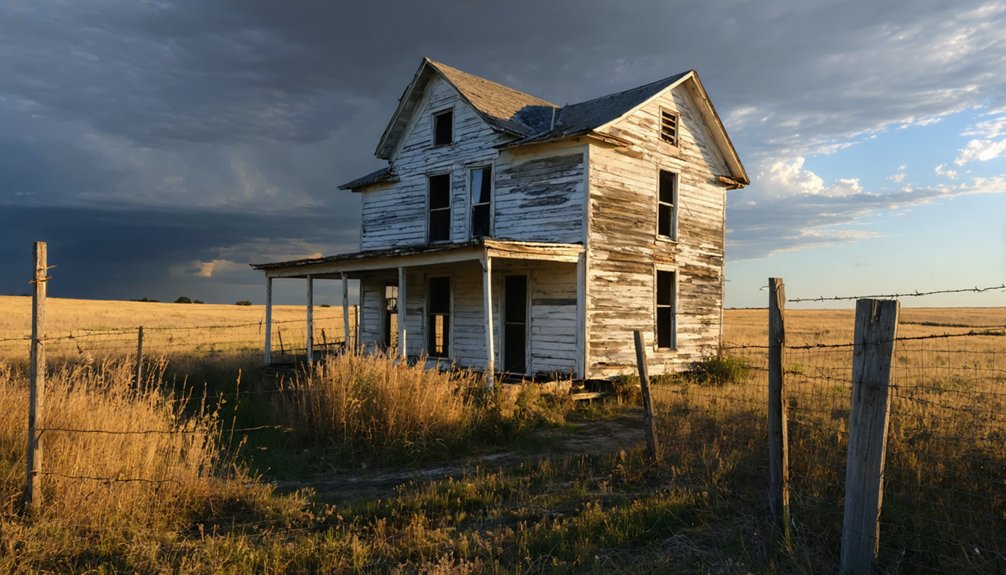You’ll find the remains of Senterfitt in Lampasas County, Texas, where Reuben S. Senterfitt established a thriving ranching community in the 1860s. This former hub featured hotels, mills, stores, and a post office by 1877, serving as a crucial stagecoach stop between Fort Worth and Fort Mason. While economic challenges and bypassing railroad routes led to its decline, stone foundations and the Senterfitt cemetery still preserve the legacy of this frontier settlement.
Key Takeaways
- Senterfitt was established in the 1860s as a thriving Texas ranching community with hotels, stores, and a post office.
- The town served as a vital stagecoach transportation hub from 1879, connecting Fort Worth to Fort Mason and Austin.
- Economic decline hit in the early 20th century when railroads bypassed the town, leading to mass population exodus.
- Today, only stone foundations, adobe ruins, and the historic Senterfitt cemetery remain as evidence of the former settlement.
- The ghost town’s founder, Reuben S. Senterfitt, was a prominent cattle king who donated land for community development.
The Rise of a Texas Ranching Community
During the 1860s, Reuben S. Senterfitt built his home and established a ranch in what would become the heart of Texas cowboy culture. The town that bore his name quickly emerged as ranching traditions took hold, drawing settlers who recognized the area’s potential for cattle operations. The notorious Maverick Valley nearby gained a reputation for frequent cattle rustling activities.
You’ll find that Senterfitt’s strategic location made it an ideal hub for the growing cattle industry. The town developed essential infrastructure to support the bustling ranching community, including hotels, mills, and stores. A post office soon followed, connecting the isolated frontier settlement to the wider world.
As cattle drives intensified through the 1870s and 1880s, Senterfitt became an important stop for cowboys moving herds northward. The town’s growth mirrored the expansion of Texas’s ranching empire, with its economy firmly rooted in the livestock trade. Local ranchers benefited from the surge in beef prices as national demand for beef increased dramatically at the start of the Civil War.
Reuben S. Senterfitt: Pioneer and Cattle King
Reuben S. Senterfitt’s rise to prominence began in the 1860s when he established his ranching operations in Lampasas County, building a home and amassing significant cattle holdings.
You’ll find his influence grew rapidly as he became known as the region’s “cattle king,” leading the development of cattle drives and local livestock trading.
His pioneering success directly led to the town of Senterfitt being named in his honor, with the establishment of key infrastructure including a post office in 1877.
Much like John R. Allen who founded the Pleasant Valley Farmers Alliance, Senterfitt was instrumental in shaping the agricultural landscape of the region.
Demonstrating his commitment to the community’s growth, he donated land for both a cemetery and school that would serve the town’s residents.
Early Ranching Empire Beginnings
His ranching techniques reflected the era’s demands, embracing open range grazing and organizing cattle drives to distant markets.
You can trace his growing influence through his strategic use of Texas Hill Country terrain and his adaptation to post-Civil War beef markets.
His ranch didn’t just thrive – it became a nucleus for regional development, spawning a town that’d bear his name and a post office by 1877.
The family’s political impact grew significantly when Reuben’s descendant became the Texas House Speaker from 1951 to 1955.
Like John R. Allen’s influence on ranching communities, Senterfitt helped establish strong agricultural networks in the region.
Leadership Among Cattle Ranchers
While many ranchers shaped Texas’s cattle industry, few matched the commanding presence of Reuben S. Senterfitt, who earned the title “cattle king” in the 1850s.
His Confederate military service as a Private in the 27th Brigade added to his respected status in the region.
His influence woven throughout early Lampasas County, where he established one of the region’s largest cattle ranching operations and founded a town bearing his name.
His community leadership extended beyond managing vast herds. He created essential infrastructure, including a post office by 1877, while fostering economic growth through employment opportunities and strategic land management.
Through his family connections and social standing, he built powerful networks that strengthened the region’s ranching operations. His entrepreneurial spirit, combined with dedication to community stewardship, helped transform frontier settlements into stable communities, setting standards for future generations of Texas cattle ranchers.
Legacy Through Town Development
Throughout the 1860s, the development of Senterfitt town emerged as a tribute to its namesake’s pioneering vision. When Reuben S. Senterfitt established his ranch there, you’d have witnessed the birth of a community that showcased remarkable economic foundations and resilience. His cattle empire attracted merchants, workers, and essential services that transformed the area into a bustling market hub.
You’ll find Senterfitt’s legacy woven into the town’s earliest institutions. The establishment of the post office in 1877 created a central gathering point for surrounding settlements, while his home served as a significant venue for community decision-making.
His influence extended beyond ranching, as he helped establish civic organizations that strengthened the social fabric of this frontier settlement, demonstrating true community resilience in the face of pioneer challenges.
Life at the Crossroads: Stagecoach Era
During the stagecoach era, Senterfitt emerged as an essential transportation hub in 1879, serving routes from Fort Worth to Fort Mason and westward from Austin.
You’d find passengers enduring rough, jarring rides while stagecoaches carried valuable cargo like gold and express mail in Wells Fargo strong boxes secured under the driver’s seat. These valuable shipments made stagecoaches frequent targets for notorious highwaymen.
The town’s strategic location fostered trade between rural ranching areas and larger markets, bringing economic significance to the frontier settlement. Deep road ruts from heavy stagecoach traffic can still be seen today in some sections of the old routes.
Positioned at the crossroads of commerce, Senterfitt bridged the gap between ranch lands and urban markets, fueling frontier prosperity.
At Senterfitt’s way station, you could witness the exchange of fresh horses every 10 to 15 miles, ensuring sustained travel speeds across long distances.
The stop served as more than just a relay point – it became a nucleus of commerce and community interaction, connecting isolated ranchers with the broader economic opportunities of Texas’s expanding territories.
Early Settlement and Development
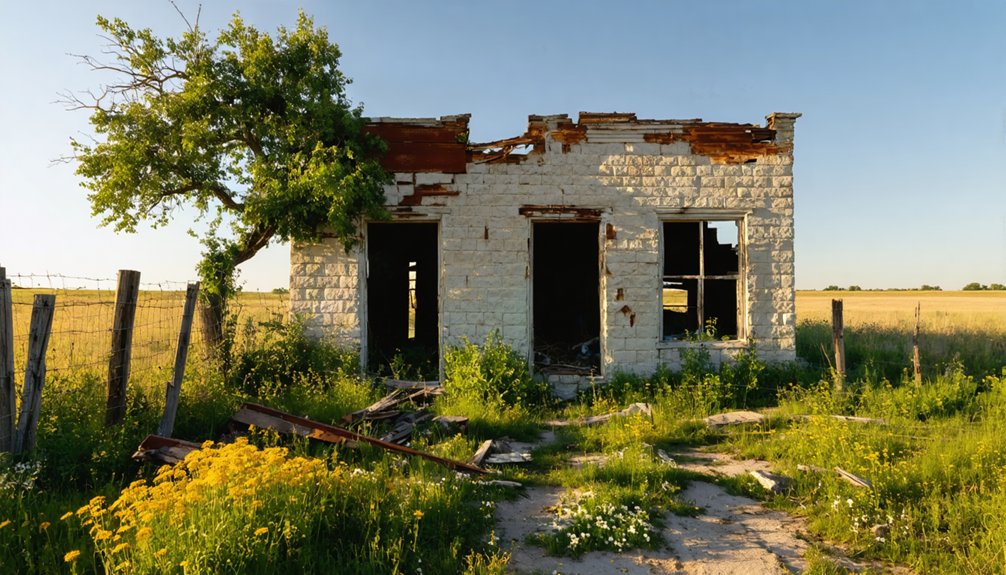
As you trace Senterfitt’s beginnings in the 1860s, you’ll find Reuben S. Senterfitt established the settlement during Texas’ post-Civil War ranching boom.
You’ll note how the town’s strategic position at the crossroads between Lampasas and San Saba made it an ideal stagecoach stop, connecting travelers and commerce throughout the region. The town gained notoriety for its wild saloon atmosphere as it developed into a bustling trade center.
Founding by Reuben Senterfitt
When Reuben “Rube” Senterfitt established his cattle operations in the 1850s, he laid the foundation for what would become the town bearing his name. As a prominent figure in Senterfitt history, he transformed the area from open range into a thriving community center.
You’ll find his influence reflected in the diverse business ventures he created, including a grocery store, mercantile business, livery stable, and hotel.
The cattle economy flourished under his leadership as the local “cattle king,” and his entrepreneurial spirit attracted more settlers to the region.
Stagecoach Stop Establishment
In 1879, Senterfitt established itself as an important stagecoach stop along two major routes: Fort Worth to Fort Mason and Austin westward. The stop’s stagecoach logistics included providing critical services for both mail delivery and passenger transport, contributing to Texas’s expanding communication network during the post-Civil War era.
You’d have found travel dangers were a constant concern, as stagecoach passengers and operators faced threats from bandits and hostile Indians throughout the region. Despite these risks, the stop played a significant role in connecting remote Texas communities.
The standard passenger fare structure reflected the era’s economic realities, with meals costing between 40 cents and $1. Like many similar outposts, Senterfitt’s stagecoach stop helped foster local economic growth by creating jobs and providing important services to travelers.
Post-Civil War Ranch Growth
Beyond the stagecoach activity, Senterfitt’s roots traced back to the 1860s through Reuben S. Senterfitt, who established the community during a post-Civil War ranching boom.
You’ll find that ranching economics drove the area’s development, as Texas maintained relatively undamaged infrastructure and livestock compared to other Confederate states.
The settlement patterns reflect the period’s agricultural expansion, with the community growing to support about 150 residents.
A mix of German immigrants and Anglo settlers created a diverse cultural landscape, while proximity to Mexico enabled continued trade despite Reconstruction challenges.
You’ll notice how the community’s strategic location at a crossroads, combined with its post office and school, made it an essential hub for surrounding ranches, serving the needs of local families and supporting the region’s thriving cattle industry.
Peak Years and Community Growth
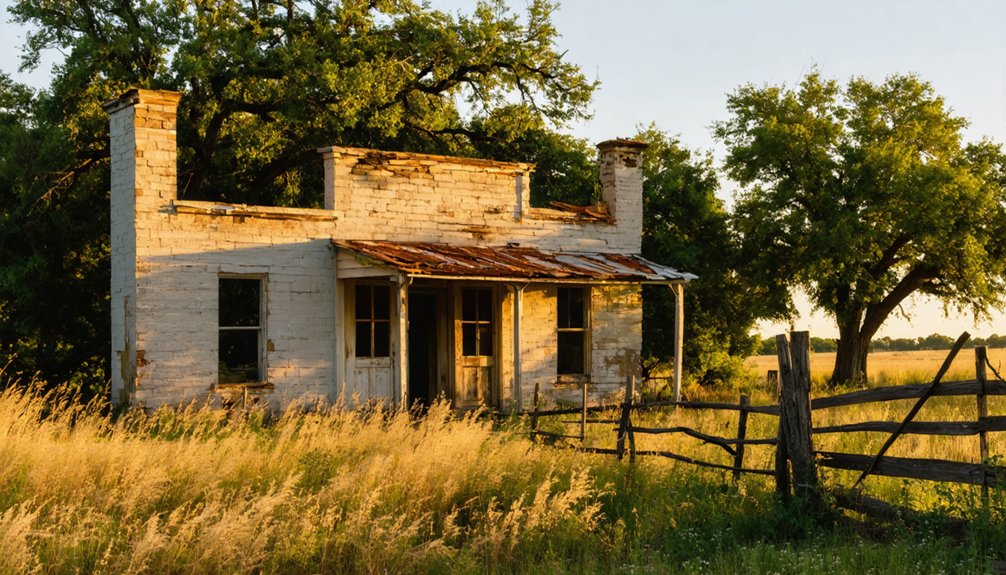
During its peak years in the late 1800s, Senterfitt flourished as a bustling ranching community with approximately 381 residents.
You’d find economic resilience through the town’s strategic position as a stagecoach stop between Lampasas and San Saba, while cattle ranching drove the local economy forward.
The community dynamics centered around a well-established infrastructure, including a post office established in 1877, general stores, and blacksmith shops.
You’d see travelers stopping to rest and resupply, while ranchers conducted their cattle business.
The town supported various essential services, from lodging establishments to trading posts, creating a self-sufficient rural hub.
Local businesses thrived by serving both the resident ranching families and the steady stream of stagecoach passengers moving through the region.
The Decline of a Once-Thriving Town
Senterfitt’s vibrant community life began to unravel as multiple economic forces converged in the early 20th century.
You’d have witnessed the town’s economic challenges intensify when its primary industry closed, triggering a mass exodus of residents seeking opportunities elsewhere. While some younger folks tried returning, drawn by affordability and safety, their numbers weren’t enough to sustain community resilience.
The town’s decline accelerated as key institutions relocated, leaving behind empty storefronts and abandoned buildings.
Transportation changes dealt another blow when new railroad routes bypassed Senterfitt, redirecting commerce to neighboring towns.
Eventually, the land was largely privatized, and the once-bustling streets fell silent.
What remains today are ghostly remnants of a community that couldn’t weather the powerful shifts in regional development and economic patterns.
Historical Landmarks and Remnants
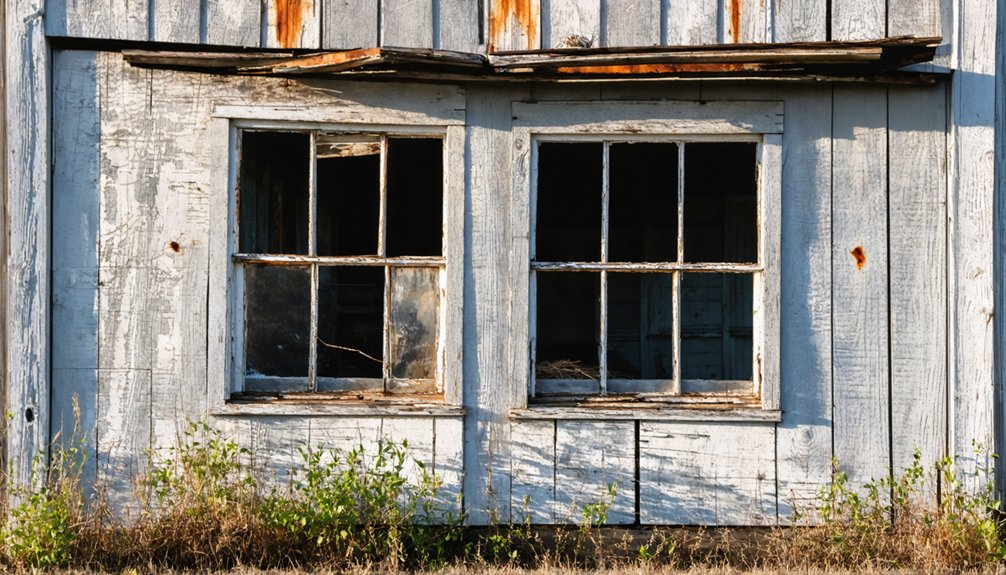
Today’s visitors to Senterfitt will find scattered physical evidence of the former frontier settlement, with stone and adobe foundations marking where buildings once stood.
You’ll discover the remains of the old stage stand and post office site near Salt Creek, though most above-ground structures have succumbed to time and weather.
The Senterfitt cemetery stands as the site’s most significant historical landmark, featuring weathered 19th-century grave markers, iron crosses, and wooden monuments that tell the story of early settlers.
A historical marker commemorates Reuben S. Senterfitt and the town’s ranching heritage.
While preservation challenges threaten the site’s remaining artifacts and foundations, you can still trace the old roads and paths that once connected this frontier community.
Archaeological evidence, including ceramics and ranching tools, continues to surface, offering glimpses into frontier life.
Legacy in Lampasas County
Although now a ghost town, Senterfitt left an indelible mark on Lampasas County’s development through its role in the post-Civil War ranching boom. The town’s economic transformation, led by cattle king Reuben S. Senterfitt, shaped the region’s ranching industry and established essential trade routes that would influence future growth patterns.
Senterfitt’s pioneering spirit and ranching legacy transformed Lampasas County, establishing vital trade networks that shaped the region’s future development.
- Served as a significant stagecoach stop and communication hub, fostering community resilience through its post office and social gatherings.
- Contributed to regional identity through its ranching heritage and pioneer spirit.
- Established important transportation networks that connected western Lampasas County.
- Created lasting impact on local market development and agricultural activities.
- Preserves historical lessons about rural settlement patterns and community formation.
Today, you’ll find Senterfitt’s legacy woven into the county’s collective memory, tourist attractions, and educational programs.
Preserving Senterfitt’s Memory
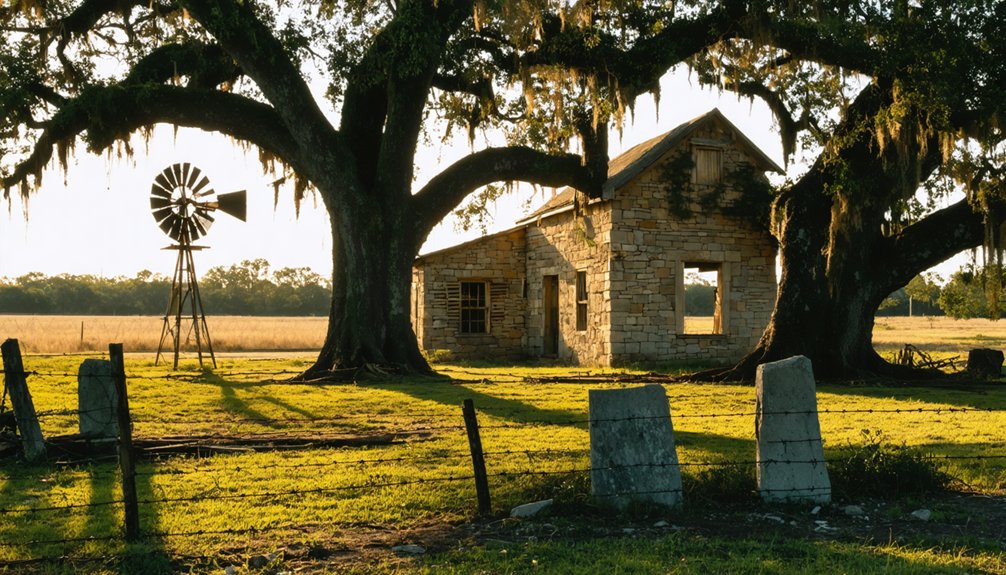
Preserving the memory of this once-thriving community relies heavily on historical documentation, as physical remnants of the original structures no longer exist.
You’ll find Senterfitt’s legacy maintained through historical markers, archive databases, and digital storytelling platforms that commemorate its founder, Reuben S. Senterfitt, and the town’s ranching origins.
Local museums and historical societies play an essential role in collecting artifacts and oral histories from descendants, while heritage tourism initiatives help keep the town’s story alive.
The Handbook of Texas and other archival resources guarantee that future generations can access detailed records of this ghost town’s past.
Through interpretative signage, community events, and online preservation projects, you’re able to connect with Senterfitt’s rich history despite its physical absence from the landscape.
Frequently Asked Questions
Are There Any Documented Ghost Stories or Paranormal Activities in Senterfitt?
Have you ever searched for spirits in Senterfitt? You won’t find documented ghost sightings or haunted locations here – historical records and paranormal databases show no evidence of supernatural activity in this area.
What Natural Disasters or Significant Weather Events Affected Senterfitt’s Development?
You’ll find no documented natural disasters specific to Senterfitt, though regional drought challenges likely impacted cattle ranching. While flood impacts affected nearby areas, they aren’t directly linked to Senterfitt’s development.
Did Any Notable Crimes or Outlaws Pass Through Senterfitt?
You won’t find documented outlaw legends or major crime history in Senterfitt. Historical records show no notable criminals passing through, as the town focused primarily on legitimate ranching activities.
What Native American Tribes Originally Inhabited the Senterfitt Area?
You’ll find the Tonkawa’s cultural heritage most prominent there, with Comanche and Apache tribal traditions later dominating the region. The Tawakoni people also maintained hunting grounds in this territory.
Were There Any Significant Archaeological Finds in the Senterfitt Region?
While there’s no record of significant archaeological finds directly in Senterfitt, you’ll find notable historical artifacts and archaeological significance in nearby areas like the San Esteban Rockshelter and Gault Site.
References
- https://www.hmdb.org/m.asp?m=175313
- https://en.wikipedia.org/wiki/List_of_ghost_towns_in_Texas
- https://www.tshaonline.org/handbook/entries/senterfitt-tx
- https://texashistory.unt.edu/ark:/67531/metapth61101/
- https://discovertexasoutdoors.com/places/senterfitt-texas-a-stagecoach-stop-turned-ghost-town-in-lampasas-county/
- https://www.lampasasedc.com/115/History
- https://www.thestoryoftexas.com/discover/campfire-stories/cattle-ranchers
- https://www.texasalmanac.com/places/senterfitt
- https://www.hmdb.org/m.asp?m=175312
- https://www.trinity.edu/news/football-farming
